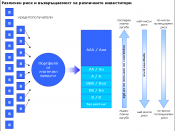Human Resources - Return on Investment
The tight labor market is making it difficult to find qualified and experienced employees. Retaining those already present is much more cost-effective than replacing them. Innovative means of enabling employees to balance work and home life can have a greatly positive effect both on employee morale and on the organization's bottom line. There are various ways to calculate and measure the benefits of training and development. The firm must make a cost/ benefit assessment and according to the results, initiate the training programs. A firm can accomplish this through the measure of a business's overall performance in relation to its investment capital, or Return on Investment (Link and Boger 15).
Return on investment (ROI) is the information a company looks for to determine the value of a business plan. Human resource departments must show a return on investment like any other organizational department and performance measurements are key to accomplishing this objective.
The standard ROI measurement, which many training professionals use, is a formula that divides net program benefits (total benefits less costs) by program costs, multiplied by 100. The result of this calculation shows that for every dollar invested in the training program, there is a return in net benefits of a certain amount of money.
In figuring the ROI, the human resources function can gain credibility as management's true strategic business partner by quantifying its contributions to the organizations in terms of dollars and cents. Through the measurement of its return on investment, HR can demonstrate that it supports the company's financial goals and objectives. It can, therefore, avoid being considered as 'overhead', a function that consumes resources without adding value, and gain legitimacy as a 'strategic business partner,' or a business unit that directly contributes to the bottom line. HR areas...


